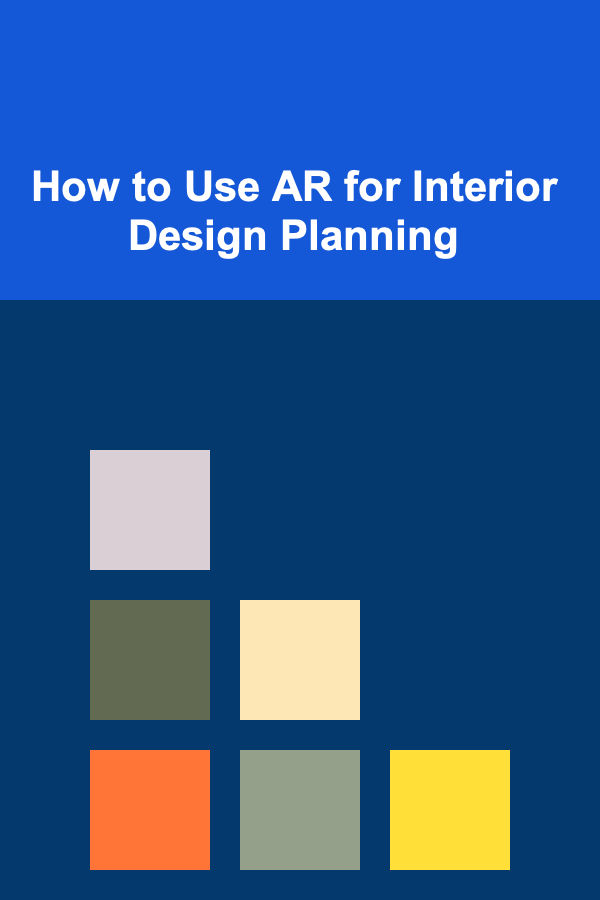
How to Use AR for Interior Design Planning
ebook include PDF & Audio bundle (Micro Guide)
$12.99$6.99
Limited Time Offer! Order within the next:

In the world of interior design, the integration of technology has revolutionized how designers and homeowners plan and visualize spaces. Augmented Reality (AR) is one such transformative technology that is helping individuals and professionals alike reimagine how they approach interior design. AR offers the potential to change the design process by allowing people to visualize furniture, colors, textures, and layouts in real-time, within their actual living spaces.
This article explores how Augmented Reality can be used for interior design planning. It dives deep into its benefits, how it works, tools available for both professionals and DIYers, and how AR is shaping the future of interior design.
What is Augmented Reality (AR)?
Augmented Reality (AR) is a technology that overlays digital information---such as images, sounds, or text---onto the real world, usually through the use of smartphones, tablets, or AR glasses. Unlike Virtual Reality (VR), which creates an entirely artificial environment, AR enhances the physical world by adding digital elements to it, making it interactive and immersive.
In the context of interior design, AR allows users to see virtual objects and elements like furniture, wall colors, and décor items in their actual living spaces before making any purchasing decisions. By using AR, designers and homeowners can plan layouts, experiment with different design options, and make real-time decisions without needing to move or rearrange any physical objects.
Benefits of Using AR for Interior Design
There are numerous advantages to incorporating AR into the interior design process, both for designers and homeowners. These benefits extend beyond simple visualization and can help save time, money, and effort during the design and planning stages.
2.1 Visualization in Real-Time
The most obvious benefit of using AR in interior design is its ability to provide real-time visualization. This helps designers and homeowners understand how a particular piece of furniture, paint color, or layout will look in a specific space. Unlike traditional methods where designers rely on 2D floor plans or physical samples, AR allows them to superimpose the digital version of a product into the physical environment, making it much easier to make design decisions.
2.2 Enhanced Accuracy and Precision
With AR, the accuracy of the placement of furniture and other design elements is enhanced. Users can scale digital objects to the exact dimensions of the space they are working with, ensuring that everything fits perfectly. This eliminates the guesswork that often accompanies traditional interior design planning and provides a higher degree of precision.
2.3 Cost and Time Savings
AR enables homeowners and designers to experiment with different designs without spending money on samples, prototypes, or materials. This results in fewer mistakes, saving both time and money. By seeing the effects of changes in real-time, designers can fine-tune their designs and make informed decisions without the need for costly trial and error.
2.4 Personalization and Customization
AR technology allows for a highly personalized design experience. Homeowners can experiment with different styles, colors, and layouts without committing to any changes until they find the ideal solution. With AR, the design process becomes more iterative, allowing for a customized solution that fits personal preferences and needs.
2.5 Interactive Design Process
AR offers an interactive experience for both professionals and clients. Designers can walk clients through different designs, allowing them to make real-time adjustments based on feedback. This collaboration creates a more dynamic and engaging design process that enhances communication and understanding.
How AR Works for Interior Design
AR works by using the camera on a mobile device or AR glasses to capture the environment. This environment is then processed by the device, which recognizes surfaces, dimensions, and features in the room. After this, digital objects are projected into the real world, and their placement is adjusted according to the dimensions and layout of the space.
There are several key components that enable AR to function effectively in interior design:
3.1 Tracking and Mapping
For AR to work in interior design, it first needs to map out the physical space. This is typically done using sensors, cameras, or depth-sensing technology that track surfaces and objects within the room. Once this data is captured, it helps the AR system determine where to place digital elements within the real-world space.
3.2 Real-Time Rendering
Once the mapping is complete, the AR system can render digital objects (such as furniture, wallpaper, or décor items) in real-time. This rendering is usually highly detailed, allowing users to view items from different angles, adjust lighting, and make other design modifications on the fly.
3.3 Interaction and Adjustment
One of the most important aspects of AR for interior design is the ability to interact with digital elements. Homeowners and designers can scale, rotate, and move digital objects around the space, changing their positioning and layout to see how they fit. This allows for experimentation with different combinations and arrangements without needing to physically move anything.
AR Tools and Applications for Interior Design
Numerous apps and platforms utilize AR technology to assist with interior design planning. These tools cater to different types of users, from professional designers to DIY homeowners. Below are some of the most popular AR tools for interior design.
4.1 IKEA Place
IKEA Place is one of the most well-known AR apps in the interior design world. It allows users to see how IKEA's products will look in their homes before purchasing them. By scanning the room with the app, users can place a variety of furniture pieces in the space, adjusting them to fit the layout and style of the room. The app offers highly realistic 3D models of IKEA products and can scale them to fit the room's dimensions.
4.2 Houzz
Houzz is a platform for interior design inspiration, and its AR features allow users to visualize products in their homes. With the "View in My Room" feature, users can take a photo of their space and place items like furniture, rugs, and lighting fixtures into the image. This tool helps users make decisions based on the design and aesthetic of their actual environment.
4.3 RoomScan Pro
RoomScan Pro is a popular app for creating floor plans, and its AR features help users visualize how furniture and décor will fit into their spaces. Users can simply walk around the room, and the app will map out the dimensions and layout. The app can then place virtual furniture in the mapped area, showing how different pieces fit into the space.
4.4 MagicPlan
MagicPlan is a powerful AR app that helps users create floor plans and visualize designs in 3D. With its AR capabilities, users can scan their space to create accurate floor plans and then explore design possibilities by adding virtual furniture and décor. MagicPlan is useful for both professional designers and homeowners, offering detailed designs and layout suggestions.
4.5 Architectural Digest's AR Feature
Architectural Digest, known for its high-end interior design content, offers an AR feature on its app, which allows users to place digital furniture in their rooms. This feature is particularly useful for those who want to experiment with luxury designs and see how they would look in their own home before committing to a purchase.
4.6 Snapchat and Instagram AR Filters
Social media platforms like Snapchat and Instagram have also integrated AR technology into their design tools. While they are more focused on social interaction, users can use these platforms to experiment with how certain styles or furniture pieces might look in their homes. Filters that place virtual items within photos can provide a fun, albeit more basic, introduction to AR in design.
How AR Is Shaping the Future of Interior Design
The future of interior design is inevitably linked to technological advancements, and AR is at the forefront of this revolution. As AR continues to evolve, it is expected to enhance every stage of the design process, from conceptualization to implementation.
5.1 More Accurate and Immersive Visualization
As AR technology improves, the accuracy and realism of visualizations will continue to enhance. Future AR tools may incorporate features like texture recognition, allowing users to see how different materials---like wood, fabric, or tiles---will look and feel in a given space. The more detailed the virtual design, the more effective AR becomes as a planning tool.
5.2 Integration with Other Technologies
The integration of AR with other emerging technologies, such as Artificial Intelligence (AI) and Internet of Things (IoT) devices, will bring even more sophisticated features. For instance, AI could help users by suggesting design choices based on their personal preferences or the overall aesthetics of their home, while IoT devices could allow AR to adjust lighting and furniture placement based on real-time environmental data.
5.3 Increased Collaboration Between Designers and Clients
AR can transform the way designers collaborate with their clients. With AR, designers can work directly with their clients in the same virtual space, making real-time modifications and discussing changes as they happen. This will create more dynamic and interactive design processes that allow for better communication and faster decision-making.
5.4 Wider Adoption and Accessibility
As AR technology becomes more affordable and user-friendly, it will become more accessible to the general public. Future advancements may allow anyone to design their home without needing extensive technical expertise. The democratization of AR tools will enable homeowners to take full control of their design process, experimenting with styles and layouts at their own pace.
Conclusion
Augmented Reality is a game-changer for the interior design industry. By enhancing visualization, providing real-time interactions, and saving time and money, AR has revolutionized how design decisions are made. Whether you are a professional designer looking for a more efficient way to communicate ideas to clients, or a homeowner eager to explore different design options in your own space, AR provides an invaluable tool for planning and visualizing interior spaces.
As technology continues to improve, the possibilities for AR in interior design are limitless. With greater accuracy, more immersive experiences, and easier access to tools, AR will continue to shape the future of how we design and live in our spaces. Whether for residential or commercial projects, AR is a powerful ally in creating the perfect space for everyone.
Reading More From Our Other Websites
- [Stamp Making Tip 101] DIY Stamp Designing: Tools, Techniques, and Creative Tips
- [Home Renovating 101] How to Repair Drywall Like a Professional
- [Home Security 101] How to Build an Effective Home Safety Checklist: Key Security Elements to Include
- [Reading Habit Tip 101] The 'One‑Hour Rule': How Leaders Structure Their Reading Time for Maximum Impact
- [Personal Financial Planning 101] How to Manage Your Finances During a Career Change
- [Home Pet Care 101] How to Set a Pet-Friendly Budget
- [Personal Financial Planning 101] How to Create a Budget That Actually Works: Tips for Success
- [Home Budget Decorating 101] How to Use Mirrors to Make Your Home Look Bigger and Better
- [Small Business 101] Best Sustainable Sourcing Practices for Small Apparel Brands
- [Tiny Home Living Tip 101] How to Use Vertical Gardening Techniques to Grow Food in a Tiny Home's Limited Footprint

How to Maximize Storage Space During Your Home Renovation
Read More
How to Write a Strong Professional Reference List
Read More
How To Get Started with Esports Coaching
Read More
The Art and Science of Homemade Mayonnaise
Read More
How to Build a First Aid Kit for Hiking and Backpacking
Read More10 Tips for Tracking Travel Expenses in Multiple Currencies
Read MoreOther Products

How to Maximize Storage Space During Your Home Renovation
Read More
How to Write a Strong Professional Reference List
Read More
How To Get Started with Esports Coaching
Read More
The Art and Science of Homemade Mayonnaise
Read More